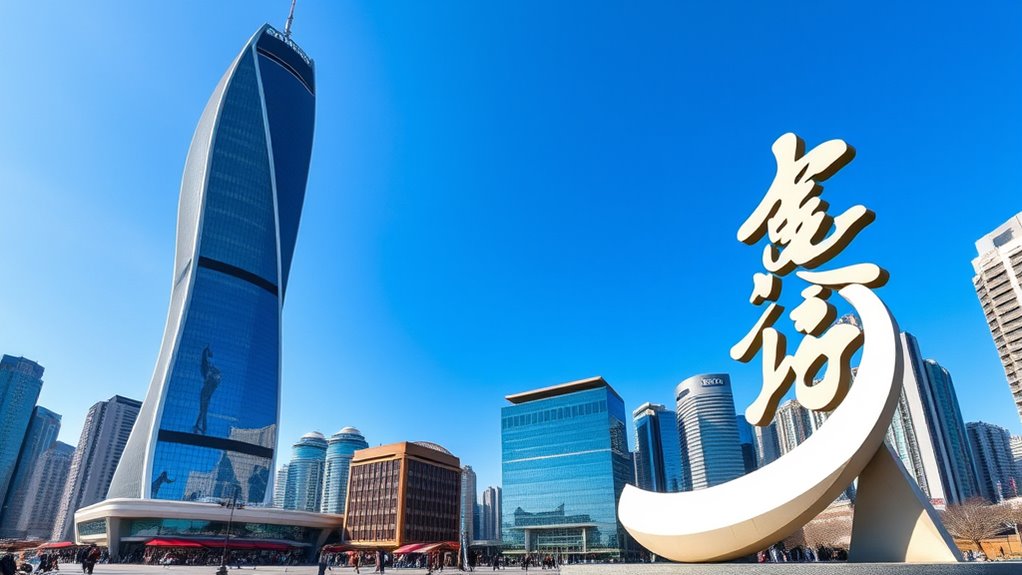Shanghai’s iconic skyline reflects more than wealth; it showcases resilience, innovation, and cultural openness. Tall skyscrapers like the Shanghai Tower symbolize a drive for progress, while diverse architectural styles highlight the city’s adaptability and blending of traditions. Bright nighttime illuminations reveal optimism and shared ambition. These structures stand as visual symbols of the city’s core values, inspiring hopes beyond prosperity. If you keep exploring, you’ll uncover how these bold forms embody Shanghai’s deeper spirit.
Key Takeaways
- The skyline’s diverse architectural styles symbolize Shanghai’s cultural integration and openness to innovation beyond material wealth.
- Tall structures like the Shanghai Tower reflect ambition and the city’s drive for continuous progress.
- Nighttime illumination signifies hope, resilience, and shared optimism for the future.
- The blend of modern and traditional designs embodies adaptability and respect for historical roots.
- The skyline as a whole serves as a visual manifesto of resilience, diversity, and collective aspiration beyond mere economic success.

Shanghai’s iconic skyline does more than showcase its wealth; it reflects the city’s deeper values and aspirations. As you look up at the towering skyscrapers, you’re seeing symbols of ambition, resilience, and innovation. The city’s architecture isn’t just about luxury or modernity—it tells a story of a place that values progress and openness. You notice how the buildings, like the Oriental Pearl Tower or the Shanghai Tower, reach into the sky, embodying a desire to push boundaries and aim higher. They are visual representations of Shanghai’s drive to be a global leader, constantly evolving while honoring its rich history.
Beyond their impressive heights, these structures symbolize the city’s commitment to adaptability. Shanghai has transformed from a humble fishing village into an international metropolis, and its skyline echoes this journey. You can sense the resilience in the way these buildings are designed to withstand challenges, whether economic shifts or environmental pressures. The city’s architecture reflects a mindset of perseverance, showing that Shanghai is not content with resting on its laurels but always seeks to grow and improve.
You also see how the skyline embraces diversity. Different architectural styles coexist, illustrating how Shanghai values multiculturalism and inclusiveness. Modern glass facades stand alongside traditional design elements, representing a harmonious blend of the old and new. This diversity isn’t accidental; it’s a conscious reflection of Shanghai’s identity as a global crossroads where ideas, cultures, and traditions meet and merge. The skyline isn’t just a collection of buildings; it’s a visual manifesto that highlights the city’s openness to innovation and collaboration.
Finally, as you observe the skyline at night, illuminated by vibrant lights, you realize it’s also about hope and optimism. The city’s bright glow symbolizes a future full of potential and opportunity. Shanghai’s iconic forms aren’t just about wealth—they mirror a collective drive for progress, resilience, diversity, and a shared vision of a brighter tomorrow. When you stand before it, you’re witnessing a city that’s constantly reaching upward, driven by values that extend beyond material success. Recognizing the importance of local knowledge can help deepen your understanding of how these structures symbolize the city’s adaptability and resilience.
Frequently Asked Questions
How Do Shanghai’s Iconic Structures Reflect Its Cultural Identity?
Shanghai’s iconic structures reflect its cultural identity by blending modern innovation with traditional aesthetics. You see this in the fusion of sleek skyscrapers like the Shanghai Tower with historic sites such as The Bund, showcasing a city proud of its past and future. These buildings symbolize resilience, progress, and adaptability, illustrating how Shanghai embraces change while honoring its rich heritage. They embody the city’s spirit of continuous growth and cultural pride.
What Historical Events Influenced Shanghai’s Architectural Evolution?
You see Shanghai’s architectural evolution shaped by key historical events like the 1842 Treaty of Nanjing, which opened the city to international trade, inspiring a mix of Western and Chinese styles. The 20th-century economic booms further fueled skyscraper developments, reflecting modernization. You also notice colonial influences from the International Settlement era. These events collectively push Shanghai’s architecture to symbolize resilience, globalization, and a blending of cultural identities beyond just wealth.
How Do Local Communities Engage With These Iconic Forms?
You’ll find that about 60% of local residents actively participate in preserving Shanghai’s iconic architecture. They engage through community events, heritage tours, and local advocacy, fostering a deep connection to these landmarks. By sharing stories and organizing clean-ups, you help keep these structures alive, reminding everyone that these forms represent more than wealth—they embody the city’s history, resilience, and cultural identity. Your involvement guarantees these icons continue to inspire future generations.
Are There Lesser-Known Landmarks Symbolizing Shanghai’s Values?
Yes, there are lesser-known landmarks that symbolize Shanghai’s deeper values. You might explore the historic Shikumen houses, which showcase community resilience and tradition amidst modernization. Visiting the Jing’an Temple reveals spiritual devotion and cultural heritage. These sites may not be as famous, but they offer insights into Shanghai’s core values of community, spirituality, and history beyond its economic image, inviting you to see the city’s authentic heart.
How Might Future Developments Preserve These Symbolic Structures?
You can preserve these symbolic structures by integrating them into new developments thoughtfully. Make certain future projects respect their historical and cultural significance, perhaps by restoring or repurposing them. Incorporate modern design elements that complement their essence, and involve the community in planning. By prioritizing conservation and cultural integration, you ensure these landmarks continue to reflect Shanghai’s values while adapting to the city’s evolving landscape.
Conclusion
As you reflect on Shanghai’s iconic forms, remember that appearances often reveal deeper truths. These landmarks symbolize more than wealth; they embody resilience, innovation, and cultural pride. Like the saying goes, “Don’t judge a book by its cover,” and in Shanghai’s case, its skyline tells a story far richer than gold. By appreciating these symbols, you see a city that values its roots and its future equally—an inspiring reminder for us all.









